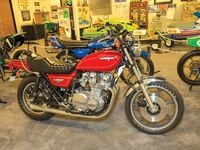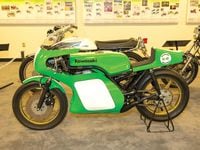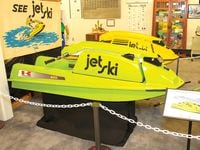The 60-by-40-foot room is located just off the main lobby of Kawasaki Motors Corp.'s Irvine, California, headquarters. But if the double doors were closed, you'd walk right by and never get a hint of the two-wheeled treasure inside.
If they were open, as they normally are during business hours, you’d spy what might be one of the most significant motorcycles in existence on display against a wall emblazoned with a “KMC Heritage Hall” graphic: a wildly styled, lime-green two-stroke roadracer with the number 21 on the fairing. That’d be the GP-spec, square-four KR500 that Eddie Lawson campaigned during the early 1980s in the AMA’s Formula One class, one of precious few KRs in the world. Call it the coolest welcome mat in all of motorcycling.
With its monocoque alloy frame and a rotary-valve 500cc engine, the exotic KR is a very special Kawasaki—and an entirely appropriate machine to have at the entrance to Kawasaki’s in-house museum. And why is that? Because its particular story says a lot about how the museum itself came together and why it even exists.
"When Kawasaki disbanded its roadrace program after Wayne Rainey won the '83 Superbike championship," longtime race-team member Norm Bigelow said, "I was told by higher-ups to destroy all the racebikes from the previous few years, including all those amazing, hand-built KZ1000s Eddie and Wayne had ridden in '81 and '82. So sad. I actually have a picture of me cutting up Wayne's and Eddie's superbikes, so I know for a fact there isn't a real one around, even though people claim they exist. When the roadrace team was shuttered, everyone worried about their jobs, so if management said, 'Cut it up,' you did."
(As an aside, this is a primary reason Wayne Rainey’s 1983 GPz750 title-winner now resides in the AMA’s Motorcycle Hall of Fame museum. Team manager Gary Mathers blessed the museum with the bike so it could escape the cutting torch and crusher.)
“Anyway, when I noticed the KR500 wasn’t on the destroy list,” Bigelow continued, “I quickly hid it, thinking I could save it and preserve it for historical purposes. And I was able to do just that by literally hiding it on the dyno room roof and covering it with tarps and boxes for several years.”
In actuality, Bigelow had already been playing this hide-the-racebike game, his well-intentioned sneakiness the result of his love of moto history and a conversation he’d had a year or two earlier with race team manager Steve Johnson. “Steve told me to never destroy a racebike if I could help it,” Bigelow said. “And absolutely never destroy one that had won a championship.”
Johnson remembers the discussion clearly: “Norm felt as I did, that upper management at the time, and probably in the future, didn’t and wouldn’t appreciate what they had or the great significance and history of it all. They too often seemed too willing to toss significant racebikes into the crusher for customs or tax reasons.” This was not a Kawasaki-only thing, as the Japanese OEs have been notoriously forward-focused, which makes them willing to sacrifice examples of their own history.
So throughout the ’80s and ’90s, as he became integral to both the motocross teams and the renewed roadracing effort with Rob Muzzy in 1990, Bigelow squirreled away all sorts of important racebikes and championship winners. There were a few from the ’70s that had somehow survived, such as early ’70s Brad Lackey and Jimmy Weinert motocrossers, and the two 24-hour record-setting Daytona machines—the Z1 from ’73 and the KZ650 from a few years later. He also began to save current racebikes, roadracers, and motocrossers alike, ones being retired every year or so once newer and better versions replaced them. Some of the earlier ones were handmade works bikes, while others were highly modified production machines fitted with exotic parts.
“I saved Jeff Ward bikes, Mike LaRocco bikes, Ricky Carmichael bikes, and James Stewart bikes,” Bigelow said with a grin. “And later, Scott Russell and Eric Bostrom bikes. It was cool. I felt I was preserving as much history as I could get away with.”
But Bigelow wasn’t alone in his bike-hiding and history-saving shenanigans—even though at the time he had no idea what would happen to all these motorcycles or where they would end up. Robert Moffit, who ran Kawasaki’s motorcycle marketing for many years before retiring in late 2002 after 28 years with KMC, was doing a lot of the same thing—only on the streetbike side.
“Bob [Moffit] had been collecting a lot of important streetbikes,” Bigelow said, “including what’s probably our most significant machine: the VIN 004 Z1 with just 5 miles that’s currently in our museum. The first few Z1s off the production line were sold cheap to VIPs and editors, and this one somehow got passed along to someone else, still in the crate. That second buyer was reportedly killed in Vietnam, and when the family contacted Moffit about a sale, he quickly bought it. It’s got a little patina from being in that crate for so long, but it’s really, really special. It may be the only one of its kind in the world—basically untouched and never ridden except for the rolling-road running test at the factory.
“At some point,” Bigelow continued, “Moffit wanted to have a museum or display at KMC headquarters for all this stuff, and it’s said that the design of our current lobby, which is open and airy and quite conducive to bike displays, was done for exactly that purpose. I felt the same way. But for whatever reasons—budget, time, et cetera—it never happened, and many of the bikes remained jammed into a large storage room Moffit had set aside.”
Thanks to Bigelow’s efforts, there were many more bikes hidden here and stuffed there, and still others on pallet racks in the warehouse 30 to 40 feet above the ground. Bigelow had put them there with a forklift, along with all sorts of other crates, bikes, and paraphernalia, knowing they’d be reasonably safe there, away from prying eyes and questions about what was what. “Of course,” he related with a grin, “some of the other hiding places weren’t as secure. Bikes were in the dyno room, in storage containers, in crates, wherever I could find space. It got to be a game: Don’t let anyone find them!”
When Moffit retired at the end of 2002, he asked Bigelow to keep pushing the museum idea with management. Bigelow was happy to keep saving and hiding motorcycles but wondered what he, a lowly race-team/shop guy, could really accomplish with Japanese upper management, who were still, even in the early 2000s, not quite sure what sort of impact all this old stuff could have on sales and brand strength.
Actually, Bigelow had already been generating some positive brand/legacy impact for Kawasaki, loaning special bikes for display at popular events such as Supercross races or to the Motorcycle Hall Of Fame Museum at AMA headquarters in Pickerington, Ohio. These were subtle promotions, but with baby boomers in their 50s and 60s at the time, and most looking back fondly at their younger motorcycling years, the displays and public showing of these special machines were well received.
Recession-oriented layoffs struck the industry hard in the late 2000s, and despite (or because of) his 30-plus years at Kawasaki, Bigelow was let go in the restructuring. It took him a while to come to terms with it. Still, the museum thing didn’t die with his departure.
“Dave Dora,” Bigelow remembered, “another executive who was about to retire, was a history buff, and he took the reins. He kept pushing the idea, got some budget, and actually got the go-ahead to get the room built. Problem was, no one there had any clue what bikes they had or where things were. I began hearing from employees, asking for help, and hearing that things were frustrating and confused. So I offered to help, to volunteer, despite the sting of being let go. I mean, I’d worked for 30 years to allow something like [the museum] to happen, and I didn’t want to let it die or be done poorly.
“And so,” Bigelow added, “with a group of volunteers and some employees, we got things moving, with the room finally opening up in 2011. We had a VIP/press day early on, and everyone there seemed to enjoy the bikes and displays. Slowly but surely over the last few years, we’ve cycled bikes through and added new stuff when it became available. We’ve also taken in loads of trinkets and historical stuff from longtime employees, all of whom seem really interested and proud of the room and what it stands for—especially since 2016 is the 50th anniversary of Kawasaki in America. And that is a story in itself!”
Although the room isn’t that large, there is a lot there, including one of the very first Jet Skis (hand-laid fiberglass body), several championship motocrossers, streetbike icons, such as that unridden and totally original Z1, to the very first—VIN 001—KZ900 LTD from 1976 (which makes it Japan’s first cruiser), to the VIN 001 Ninja 900 from 1984. The KMC Heritage Hall is open every day to the public free of charge and easily worth a visit if you’re in Southern California.
If you go, and you should, give that KR500 a close look. After all, it contains some of the earliest roots of the Heritage Hall. And if you happen to see Norm Bigelow (he works there a day or two a week nowadays), say hello. And shake his hand. Because without him, Kawasaski’s Green Room wouldn’t exist.
Kawasaki is in the process of moving its Southern California headquarters, with the new facility expected to open near the end of June 2016.











/cloudfront-us-east-1.images.arcpublishing.com/octane/WMUK2J7W6A6ERLCQZ4KZWXQG5U.jpg)








/cloudfront-us-east-1.images.arcpublishing.com/octane/GTCXACQGJ5HAPDTGWUQKDEH44E.jpg)
/cloudfront-us-east-1.images.arcpublishing.com/octane/S35YGSEMEZB4BLTDJTSZPF4GLA.jpg)
/cloudfront-us-east-1.images.arcpublishing.com/octane/5UOT6HPX2JFMRJAX6EH45AR4MQ.jpg)
/cloudfront-us-east-1.images.arcpublishing.com/octane/OKWOJWAKP5EP3OACCRRWPCIX2Q.jpg)
/cloudfront-us-east-1.images.arcpublishing.com/octane/2WF3SCE3NFBQXLDNJM7KMXA45E.jpg)
/cloudfront-us-east-1.images.arcpublishing.com/octane/G4MG6OUCJNBSHIS2MVVOTPX65E.jpg)
/cloudfront-us-east-1.images.arcpublishing.com/octane/IIGGWFOTOJGB7DB6DGBXCCMTDY.jpg)
/cloudfront-us-east-1.images.arcpublishing.com/octane/QSTCM6AVEZA5JJBUXNIQ3DSOF4.jpg)
/cloudfront-us-east-1.images.arcpublishing.com/octane/U4I7G625B5DMLF2DVIJDFZVV6M.jpg)
/cloudfront-us-east-1.images.arcpublishing.com/octane/B6XD6LS6IVCQPIU6HXDJSM3FHY.jpg)
/cloudfront-us-east-1.images.arcpublishing.com/octane/ICL63FEDDRDTTMINYICCEYGMDA.jpg)
/cloudfront-us-east-1.images.arcpublishing.com/octane/FCGZHQXRBZFLBAPC5SDIQLVF4I.jpg)
/cloudfront-us-east-1.images.arcpublishing.com/octane/WNOB6LDOIFFHJKPSVIWDYUGOPM.jpg)

/cloudfront-us-east-1.images.arcpublishing.com/octane/X33NU3E525ECRHXLNUJN2FTRKI.jpg)
/cloudfront-us-east-1.images.arcpublishing.com/octane/6KKT5NNL2JAVBOXMZYS5ZO76YA.jpg)
/cloudfront-us-east-1.images.arcpublishing.com/octane/J5RKG5O455GMPGQRF2OG6LRT7A.jpg)
/cloudfront-us-east-1.images.arcpublishing.com/octane/GX2CIZKQVRH2TATDM26KFG2DAE.jpg)
/cloudfront-us-east-1.images.arcpublishing.com/octane/ZWIDYSAKQZHD5BHREMQILXJCGM.jpg)
/cloudfront-us-east-1.images.arcpublishing.com/octane/CYUHJZCTSJCH3MRAQEIKXK7SCQ.jpg)
/cloudfront-us-east-1.images.arcpublishing.com/octane/LKOFINY56FCXJCANJ5M7ZDQUBY.jpg)
/cloudfront-us-east-1.images.arcpublishing.com/octane/4NBPDACMWJH63JQYJVK3QRBDZI.jpg)
/cloudfront-us-east-1.images.arcpublishing.com/octane/KKHQHRR3FJGX7H2IPU6RALMWG4.jpg)
